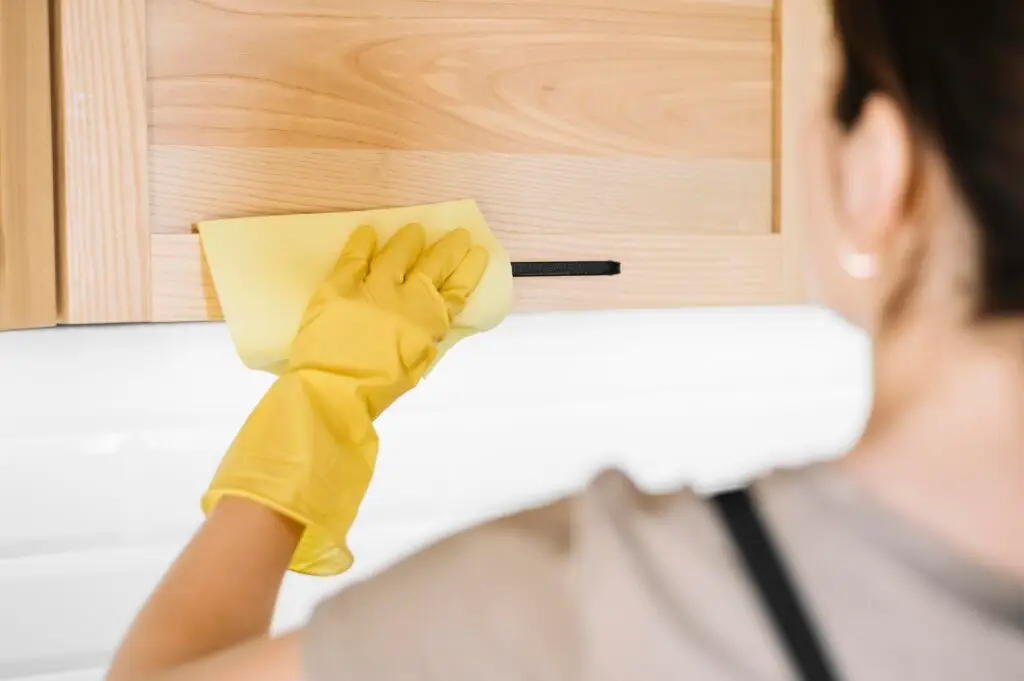You’ve just finished a cleaning marathon, and your kitchen cabinets look great—but when you touch them, they feel… sticky? It’s a frustrating and common problem that can make your kitchen feel less than clean. That lingering stickiness isn’t always a sign of a bad cleaning job; it’s often a sign of an incomplete one or the use of the wrong products. Understanding the root cause is the first step to getting that smooth, clean finish you want.
Common Causes of Sticky Cabinets
Grease Buildup Not Fully Removed
The number one culprit behind sticky kitchen cabinets is leftover grease. Cooking, especially frying and sautéing, releases tiny droplets of oil and fat into the air. This grease settles on every surface, including your cabinets. If the cleaning solution you use isn’t a powerful degreaser, it might simply spread the grease around instead of breaking it down and lifting it away. The result? A thin, sticky film that feels tacky to the touch.
Wrong Cleaner Leaving Residue
Not all cleaners are created equal. Some all-purpose sprays, polishes, or even homemade solutions can leave behind a residue that feels sticky. Cleaners with a high concentration of soap, or those that contain oils or waxes, can leave a film if not properly rinsed. Over time, this residue attracts dust and dirt, making the stickiness even worse.
Humidity and Moisture Issues
In humid climates, moisture in the air can mix with cooking grease and dust, creating a sticky coating on surfaces. If your kitchen isn’t well-ventilated, this can be a constant battle. The problem is compounded if you don’t fully dry your cabinets after cleaning, as any leftover moisture can become a magnet for airborne particles and residue.
How to Fix Sticky Cabinets
The good news is that sticky cabinets are almost always fixable with a few simple steps.
Use Degreasing Cleaners
To truly eliminate the problem, you need a cleaner that’s designed to cut through grease. A simple and effective solution is a mix of warm water and a small amount of mild dish soap. Dish soap is a powerful degreaser and works wonders on cabinet grime. For tougher jobs, a store-bought degreasing cleaner specifically for kitchens is a great choice.
Rinse Thoroughly
This is a critical step that many people skip. After cleaning with your degreaser, you must rinse the cabinets to remove all soapy residue. Use a separate, clean cloth dampened with plain water to wipe down the cabinets, ensuring all of the cleaner is gone. Repeat as needed until the surface feels completely clean.
Dry with Microfiber Cloths
Moisture is the enemy of a non-sticky surface. After rinsing, immediately dry your cabinets with a clean, dry microfiber cloth. Microfiber is ideal because it is highly absorbent and leaves no lint behind. This final step ensures that no water marks or leftover moisture can attract new dust and make your cabinets feel tacky again.
Preventing Stickiness
Once you’ve solved the problem, here’s how to prevent it from coming back.
Regular Cleaning Routine
The easiest way to prevent grease buildup is to clean your cabinets regularly. A quick weekly wipe-down with a degreasing solution can stop the problem before it starts. Incorporate this task into your weekly kitchen cleaning schedule to make it a habit.
Proper Ventilation in the Kitchen
Ensure you have proper ventilation in your kitchen. Use the exhaust fan above your stove every time you cook, especially when frying or boiling. This helps to pull grease and moisture out of the air, reducing the amount that settles on your cabinets and other surfaces.
FAQs
Will vinegar remove stickiness?
Vinegar can be an effective degreaser, but it’s not the best choice for all cabinet types. While a diluted vinegar solution works well on painted or laminate cabinets, it can be too acidic for some wood finishes, potentially dulling or damaging them over time. If you choose to use vinegar, always do a patch test first and ensure you dilute it properly with water.
Should I sand and repaint sticky cabinets?
No, this is a last resort. Sticky cabinets are almost always a surface problem caused by grease or residue, not a flaw in the paint or finish itself. Sanding and repainting would be a massive, unnecessary project. Instead, try the solutions outlined above first. A thorough degreasing and proper rinsing will almost certainly solve the issue without the need for a costly and time-consuming repaint.
Tired of sticky cabinets and frustrating cleaning problems? Let Maid Cleaning For You handle it. Our expert cleaners use professional-grade degreasers and techniques to leave your cabinets sparkling clean and residue-free. Contact us today for a free estimate and a truly clean kitchen!


